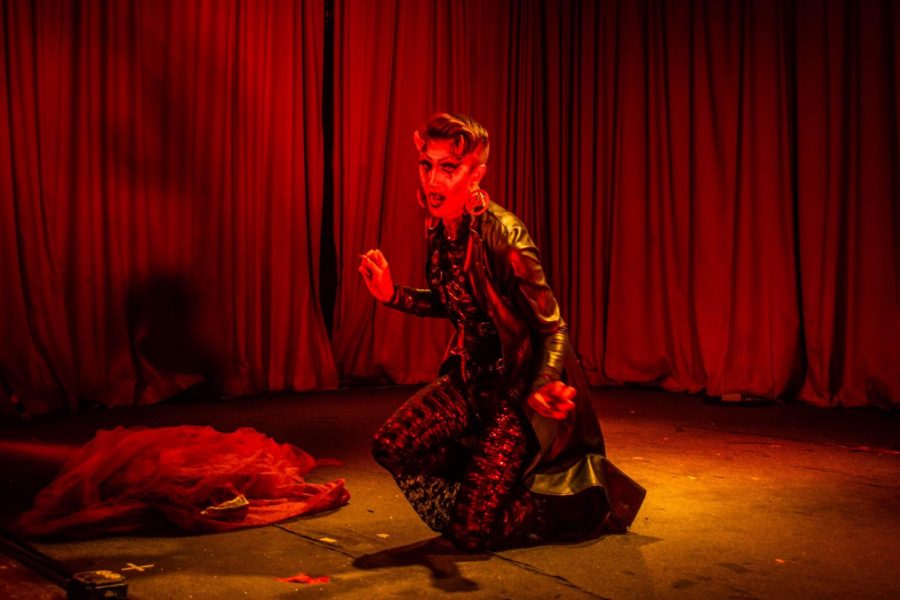Queer aesthetics in “costumes,” Cleveland LGBTQ+ performers and safe spaces
Aurora Thunder at Dragoween, hosted by the Beachland Ballroom.
In a season where LGBTQ+ youths are inundated with images of dominant groups donning queer aesthetics as costumes, the visibility of the drag community is ever more essential and magnitudinous.
Local performer and Queen Anhedonia Delight organizes GlamGore, a recurring monthly drag show series that haunts the Grog Shop on Coventry road. This October, GlamGore returned with their Halloween installment: GlamGore, Frights in Tights, on Wednesday, Oct. 30.
This amazing show featured incredible performances from Clinica Deprecious, Anhedonia Delight, Betty Whatsherface and more fabulous performers.
From irreverent biblical chaos to provocative “Blue’s Clues” mystery, GlamGore featured transcendent queer artistry and commitment to storytelling and audience engagement.
The audience of eager drag supporters roared as Anhedonia Delight, the host of the show, showcased sardonic wit and they cackled at the dripping satire of Clinica Deprecious’ high comedy performances. Betty Whatsherface captured attention with her boisterous, confrontational hilarity and charm.
But more importantly, the community that populated the Grog Shop at GlamGore epitomized what the drag community celebrates: community and acceptance. The community—with its metafamilial love and kindness—is what has drawn me into the Cleveland drag scene, and is something wholly underrated in the mainstream commercialization of drag and queer aesthetics.
Thankfully present in the social media conversational complex are dialogues about the importance of minority groups’ safe spaces; subsequently present are also dialogues critiquing majority group entitlement to those spaces.
The external pressure of such entitlement grows with mainstream exposure to a minority group: in the case of drag, RuPaul’s Drag Race.
The results of the pressures of mainstream entitlement are aggressive condemnations of the aforementioned critiques, such as oversimplifying the complexity of safe spaces into phrases like: “Drag is for everyone! Don’t gatekeep!”
To that, I ask: Who is the “everyone” that the queer community is being asked to accommodate? For what reason should minority groups be asked to actively compromise their culture for the sake of popularizing it? Is it because normalizing it can lead to a reduced marginalization from the antiqueer cisgender, heterosexual majority?
Culture is not inherently meant to be shared or appropriated. Rather, it is meant to be safeguarded and included by majority and minority groups altogether. This is something that the queer community is often best at understanding, particularly amongst those in the queer community who fall outside the standard of cisgender whiteness: black, Latinx, transgender, indigenous peoples, nonbinary and beyond.
This inclusivity of the Cleveland drag community shined once more in the Beachland Ballroom’s Nov. 1 Halloween event: Dragoween Ball.
This show featured performances ranging from undersea homages to chest-licking demonic sexuality, and demonstrated the magic of both Cleveland performers and the general Ohio drag scene.
To name a few of the glorious performers: Jared Jameson, Aurora Thunder, Dakota Cox, Samantha Echo, Pineapple, Terri Williams, Lexi Pro, Stixen Stones and so many other magnificent entertainers.
I had the opportunity to interact with many of these performers as both an audience member and offstage between performances, and can attest to the expansiveness of their hearts and their utter commitment to their craft.
It was unfortunate that the Beachland Ballroom’s price of general admission was so high, a whopping $20 at the door, attracting a consequently small audience, though not indicative of a lack of interest; Anhedonia Delight’s GlamGore, at $10 general admission price, was highly attended. A significant reduction of the Beachland Ballroom’s admission price could have encouraged a massive turnout from East Side drag enthusiasts.
I have the opportunity to share what many may have missed out on from these wonderful performances because of the high admissions price.
Imagine an atmospheric circle of light, centering on Aurora Thunder, clothed in a wispy red cloak, which soon reveals demoniac horns and sultry red body paint: a glamorous, black-lipped sex demon clad in leather. Watch her sultry, sensual rendition of Ramsey’s “Dark Side,” a song reveling in one’s surrender to intense sexuality.
Aurora Thunder portrayed the duality of sex and emotion by engaging the audience, performing one of the most intimate acts of the night: licking the bare chest of an audience member, an audience member who coincidentally happened to be the writer of this very article.
Imagine, similarly, a show-stopping “Little Shop of Horrors” homage from the talented Pineapple; fall in love with her charming command of the audience as she jigs to the iconic musical’s rocky “Prologue.”
Be immersed in the massive applause as she seamlessly transitions into the grit of “Mean Green Mother From Outerspace,” her physicality rising in intensity and expression, proportional to the growing admiration of the audience.
Overall, the performances at Dragoween and GlamGore were as inspirational as they were entertaining; the existence of queer artists, and their success, facilitates the existence of LGBTQ+ safe spaces.
I have only recently been introduced to the Cleveland drag and burlesque scene, and have been nothing less than impressed and moved by the sheer quality and heart of local performance artistry, artistry that shows us that love, acceptance and inclusivity are not a costume.


